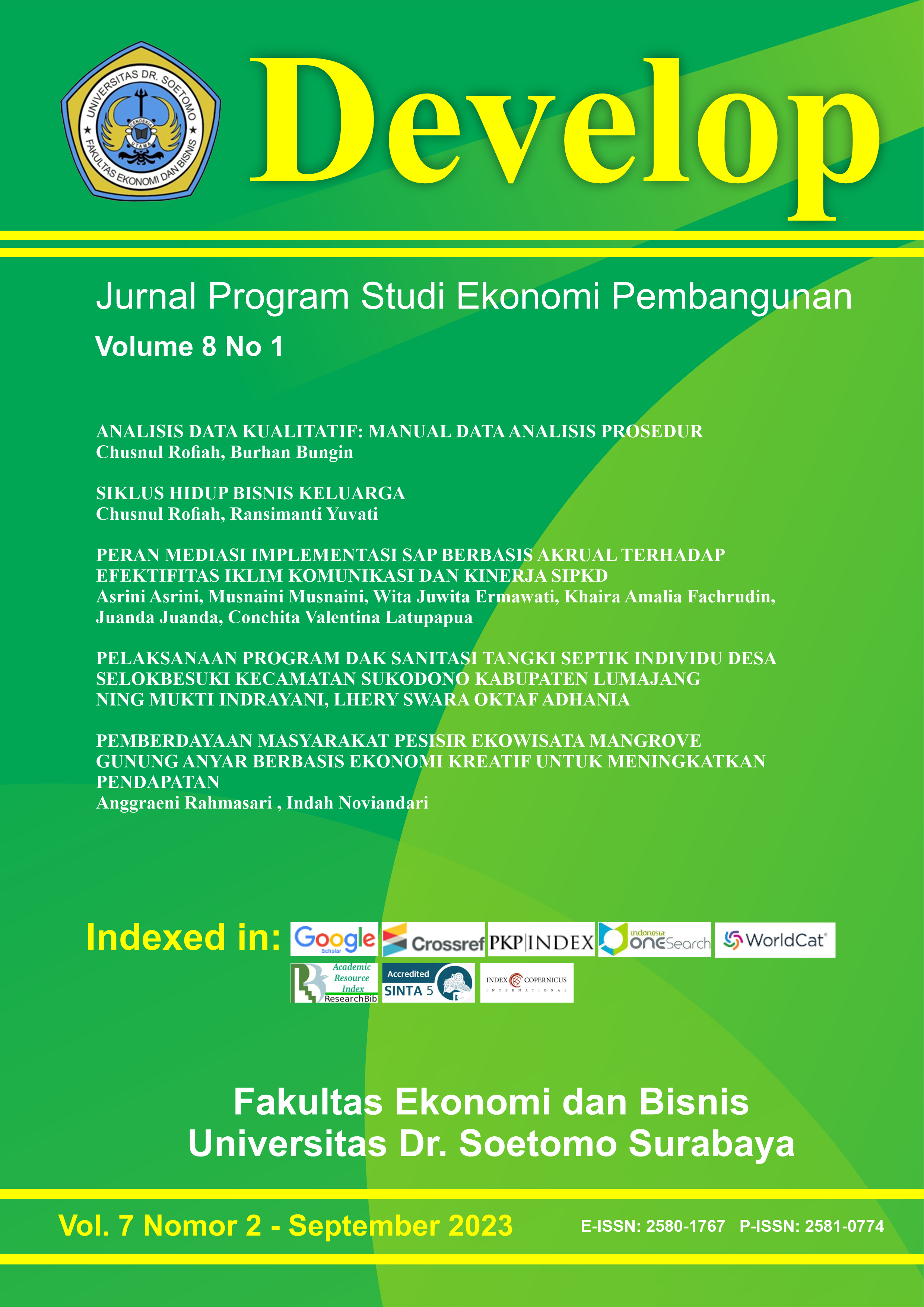ANALISIS DATA KUALITATIF: MANUAL DATA ANALISIS PROSEDUR
 Abstract views: 2024
,
Abstract views: 2024
,
 PDF Journal downloads: 3685
PDF Journal downloads: 3685
Abstract
The purpose of this article is to propose and discuss a Qualitative Data Analysis Guide: Manual Data Analysis Procedures that can be carried out independently by each researcher according to the character of the qualitative method used. Due to the realistic problems faced by qualitative researchers including: (1) Excessive reliance on qualitative software packages, (2) Excess words due to the line-by-line approach (3) Coding using a pre-formed framework, (4) Difficulty in maintaining the integrity of each respondent stories (5) The full potential of data is not exploited (6) Data analysis as an individual process. The author offers a guide to qualitative data analysis: Manual Data Analysis Procedures (MDAP) as a data analysis method that is comprehensive and systematic but not rigid; provide a space that stimulates intuition and creativity as optimally and as fully as possible. This method allows researchers to come out of their isolation and the analysis process is seen as a team activity rather than a purely individual process in order to facilitate the qualitative data analysis process, although it cannot guarantee the quality of the analysis. This method is proposed as a guiding tool rather than as a strict procedure or technique that step by step must be implemented correctly, the skills of the researcher and the general quality of the research team remain the most important components of a successful analysis process. It is very important to consider the data analysis process as a team activity, as long as the research process is not exaggerated, let alone based on conflicts of interest, funding, then whatever research results cannot be applied.
References
[2] Ayres, L., Kavanaugh, K., & Knafl, K. A. (2003). Within-case and across-case approaches to qualitative data analysis. Qualitative Health Research, 13(6), 871–883.
[3] Bailey, D. M., & Jackson, J. M. (2003). Qualitative data analysis: Challenges and dilemmas related to theory and method. American Journal of Occupational Therapy, 57(1), 57–65.
[4] Berelson, B. (1952). Content analysis in communication research.
[5] Bernard, H. R., Wutich, A., & Ryan, G. W. (2016). Analyzing qualitative data: Systematic approaches. SAGE publications.
[6] Charmaz, K. (2006). Constructing grounded theory: A practical guide through qualitative analysis. sage.
[7] Clarke, S. M., Griebsch, J. H., & Simpson, T. W. (2005). Analysis of support vector regression for approximation of complex engineering analyses.
[8] Coffey, A., & Atkinson, P. (1996). Making sense of qualitative data: Complementary research strategies. Sage Publications, Inc.
[9] Corbin, J. M., & Strauss, A. (1990). Grounded theory research: Procedures, canons, and evaluative criteria. Qualitative Sociology, 13(1), 3–21.
[10] Corbin, J., & Strauss, A. (2008). Strategies for qualitative data analysis. Basics of Qualitative Research. Techniques and Procedures for Developing Grounded Theory, 3.
[11] Daniel, B. K. (2019). What constitutes a good qualitative research study? Fundamental dimensions and indicators of rigour in qualitative research: The TACT framework. Proceedings of the European Conference of Research Methods for Business & Management Studies, 101–108.
[12] Dey, I. (2003). Qualitative data analysis: A user friendly guide for social scientists. Routledge.
[13] Froggatt, K. A. (2001). The analysis of qualitative data: processes and pitfalls. Palliative Medicine, 15(5), 433–438.
[14] Glaser, BG, Strauss, A. (1999). Grounded Theory Discoveries: Qualitative Research Strategy. Aldine Transactions.
[15] Glaser, B. G. (1978). Theoretical sensitivity. University of California,.
[16] Glaser, B. G., & Strauss, A. (1967). L.(1967). The discovery of grounded theory: Strategies for qualitative research. Chi Cago: Aldine.
[17] Guba, E. G., & Lincoln, Y. S. (1994). Competing paradigms in qualitative research. Handbook of Qualitative Research, 2(163–194), 105.
[18] Hoschek, W., & McCance, G. (2001). Grid enabled relational database middleware. Global Grid Forum, 3, 7–10.
[19] Hunter, A., Lusardi, P., Zucker, D., Jacelon, C., & Chandler, G. (2002). Making meaning: The creative component in qualitative research. Qualitative Health Research, 12(3), 388–398.
[20] Hunter, T. E., & Nosratinia, A. (2002). Cooperation diversity through coding. Proceedings IEEE International Symposium on Information Theory, 220.
[21] Jacobs, D. E. (2006). A qualitative review of housing hazard assessment protocols in the United States. Environmental Research, 102(1), 13–21.
[22] Jennings, B. M. (2007). Qualitative analysis: A case of software or’peopleware’?
[23] Krippendorff, K. (1980). Validity in content analysis.
[24] Letts, L., Wilkins, S., Law, M., Stewart, D., Bosch, J., & Westmorland, M. (2007). Critical review form–qualitative studies (version 2.0). McMaster University.
[25] Miles, M. B., & Huberman, A. M. (1994). Qualitative data analysis: An expanded sourcebook. sage.
[26] Mills, C. W. (2000). The sociological imagination. Oxford University Press.
[27] Opler, M. E. (1945). Themes as dynamic forces in culture. American Journal of Sociology, 51(3), 198–206.
[28] Polit, D. F., & Beck, C. T. (2006). The content validity index: are you sure you know what’s being reported? Critique and recommendations. Research in Nursing & Health, 29(5), 489–497.
[29] Riessman, C. K. (1990). Strategic uses of narrative in the presentation of self and illness: A research note. Social Science & Medicine, 30(11), 1195–1200.
[30] Saldaňa, J. (2009). The coding manual for qualitative researchers. Lontoo: SAGE Publications Ltd, 3.
[31] Saldaña, J. (2013). The drama and poetry of qualitative method. In Arts-based research in education (pp. 238–246). Routledge.
[32] Sandelowski, M. (1995). Qualitative analysis: What it is and how to begin. Research in Nursing & Health, 18(4), 371–375.
[33] Savage, J. (2000). One voice, different tunes: issues raised by dual analysis of a segment of qualitative data. Journal of Advanced Nursing, 31(6), 1493–1500.
[34] Shapiro, G., & Markoff, G. (1997). Methods for drawing statistical inferences from text and transcripts. Text Analysis for the Social Sciences, 9–31.
[35] Spradley, J. P. (2016). The ethnographic interview. Waveland Press.
[36] Tesch, R. (2013). Qualitative research: Analysis types and software. Routledge.
CC BY 4.0 Creative Commons Attribution 4.0 International. This license requires that reusers give credit to the creator. It allows reusers to distribute, remix, adapt, and build upon the material in any medium or format, even for commercial purposes.
BY: Credit must be given to you, the creator.



2.png)






